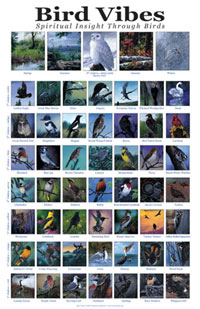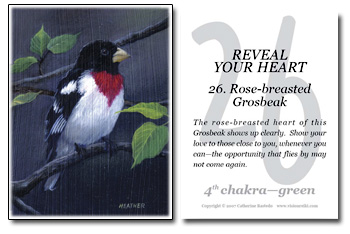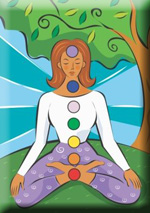More Bird Vibes:
The Herring Gulls’ Blessing
by Catherine Bastedo
Author of Bird Vibes Deck
The summer day we rescued the Herring Gull was memorable, and the visit of the gulls the next day even more so. .JPG) My daughters, then 8 and 3, had come running up the hill to the cottage in great excitement, and could barely get the words out to tell us what was wrong. When I ran down, I found a Herring Gull lying still on the rocky shore, wings folded. A length of nylon fishing line was tightly wound around its beak, keeping it shut, and a few ants were crawling along its back. The gulls’ eyes were closed. Another fish line trailed out from the top of its head and one from its back. The poor gull seemed to have made its way to shore to die.
My daughters, then 8 and 3, had come running up the hill to the cottage in great excitement, and could barely get the words out to tell us what was wrong. When I ran down, I found a Herring Gull lying still on the rocky shore, wings folded. A length of nylon fishing line was tightly wound around its beak, keeping it shut, and a few ants were crawling along its back. The gulls’ eyes were closed. Another fish line trailed out from the top of its head and one from its back. The poor gull seemed to have made its way to shore to die.
A Herring Gull is a large bird, 25 inches in length, with a wing span of almost 5 feet. Close up, it seemed that much bigger. This bird was an adult, its back pearly grey and its head white, although now it looked bedraggled and dirty. At least it was still breathing.
I ran up to the cottage to get some work gloves, a little nervous of that beak, and a pair of pliers, while the children kept watch at a safe distance. Then I slowly unwound the fish line from its beak--that was the easy part. I traced the line from the top of its head to a single fish hook, and gently tried to see how deeply the hook was embedded. The gull lay still, too worn out to resist, and it seemed to understand that we were trying to help. I gently eased this first hook out, remembering my fishing days and how I had been taught to gently twist out the hook from the gills. The children ran to get some water and let a few drops fall on its beak. The gull seemed dazed and took some time to sense the water, but it then swallowed eagerly, as if it had been far too long without.
The next fish line, in its back, led to three nasty hooks attached to the same line, and I could not work out one without the other two becoming even more deeply caught in the flesh. It required something to cut it out and I was not prepared to attempt that. So we shifted the gull into the shade, soaked some bread in water, and left it in a dish right beside it while I tried to find out what to do next. Since our cottage is on an island, there was no help nearby, but I phoned the vet’s office in the next village. They had no idea what to do--they would not treat it, and I was not to kill a Herring Gull because is a protected species in Ontario. Not the advice I was looking for! I then called our local marina, where you can find out anything worth knowing, and eventually discovered that a distance away in the woods a woman ran a wildlife centre for wounded animals, and she might help. I couldn’t reach her by phone, but what could I do except take the chance that she would be more knowledgeable and better equipped to help than I?
By this time the children reported that our gull (by now we were feeling somewhat possessive) was able to eat a little on its own but was still extremely weak, so I found an old cardboard box, and we lifted it into the box. Then the box went into the boat and my daughters watched over it while I drove the boat to the marina. Out of the boat, up the hill, into the car, onto the back seat, cover the large box with the gull inside with an old flannelette baby blanket, check the girls were settled in the back seat, and away we went. .JPG) It occurred to me that if our gull decided to stretch its wings while I was driving, I might have a real problem, so in the interests of safety I armed the older one with a “fish bonker” someone had given us as a joke--a 12 inch hardwood club--and said that if the gull got frisky, she was to bop it on the head! We did hear some noises, but the combination of its exhausted condition, close quarters in the box, and the long drive over bumpy country roads did the trick and it lay still. Luckily, because neither of the girls would ever have hurt it.
It occurred to me that if our gull decided to stretch its wings while I was driving, I might have a real problem, so in the interests of safety I armed the older one with a “fish bonker” someone had given us as a joke--a 12 inch hardwood club--and said that if the gull got frisky, she was to bop it on the head! We did hear some noises, but the combination of its exhausted condition, close quarters in the box, and the long drive over bumpy country roads did the trick and it lay still. Luckily, because neither of the girls would ever have hurt it.
When we finally arrived, it took us some time to find someone, as the place was closed, but seeing the gull, the two anxious little girls and the tired mum, a helper let us in, took the gull, and gave us a tour of this most amazing place. Here were tiny orphaned baby porcupines, hawks that had been shot and couldn’t fly, deserted wolf cubs and many other injured birds. Our gull was in good hands and so we trekked home.
The next day we were eating lunch with friends outside at a picnic table, and thinking about the whole episode. The gulls that nested on the rocks in our lake, were normally visible in the distance, but never flew over our land, even if we were eating. They had plenty of food in the lake and had no need of handouts. So we were quite astonished to see a small flock of gulls flying in a circle not too high above our heads, round and round. We all looked up, and were awed by this unusual sight. It was as if they knew what had happened the day before, and were giving us their blessing.
 Catherine Bastedo, author of the Bird Vibes meditation deck, was raised in northwestern Ontario and resides in Gatineau, Quebec. Catherine holds a master’s degree in Canadian Studies from Carleton University, is certified as a Reiki Master and Holographic Energy Master, and has been practicing Reiki since 1998. She welcomes all special stories of encounters with birds and asks that you send them to her at: cbastedo@visionreiki.com
Catherine Bastedo, author of the Bird Vibes meditation deck, was raised in northwestern Ontario and resides in Gatineau, Quebec. Catherine holds a master’s degree in Canadian Studies from Carleton University, is certified as a Reiki Master and Holographic Energy Master, and has been practicing Reiki since 1998. She welcomes all special stories of encounters with birds and asks that you send them to her at: cbastedo@visionreiki.com


Bird Vibes
Spiritual Insight Through Birds
Treat yourself to this new meditation deck!
• Receive positive, uplifting messages about current life situations and meditation paths
• Gain spiritual insight from the text on each card
• Learn more about the 8 chakras
• Discover interesting facts about 50 birds of North America
• Enjoy the 54 beautiful and unique paintings of birds and the four seasons
Bird Vibes is based on 54 birds that may be seen in various parts of North America, grouped by eight  chakras according to the bird's colour, habitat or other characteristics.Each card shows a different bird through paintings commissioned from Ottawa nature painter, Heather Bale. Use this deck to gain insight into current life situations, to connect with Nature, and the Universal Life Energy around us and within us.
chakras according to the bird's colour, habitat or other characteristics.Each card shows a different bird through paintings commissioned from Ottawa nature painter, Heather Bale. Use this deck to gain insight into current life situations, to connect with Nature, and the Universal Life Energy around us and within us.
Price: $29.95
“Bird Vibes has become my deck of choice with my
readings lately and I find people are so empowered by them. Thanks for
your double creativity!”
Julie Desmarais, Holographic Energy Master, Reiki Master Teacher Trainer
Order Bird Vibes in our Bookshop

Chakra Basics Class
taught by Mentor: Catherine Bastedo
 This class provides you with a basic knowledge of 7 chakras, from Crown to Root; facilitates your connection to your chakras and understanding of your chakras’ health; provides suggestions for ways of chakra clearing.
This class provides you with a basic knowledge of 7 chakras, from Crown to Root; facilitates your connection to your chakras and understanding of your chakras’ health; provides suggestions for ways of chakra clearing.
This class will help you learn the location of your seven major chakras and their attributes, as well as the state of health of your own chakras and how they affect your emotional and physical health. You will learn how to sense your chakras, connect with them and techniques for clearing them, through quick exercises and assignments. Since this is a “Basics” class, it emphasizes the attributes of the chakras, and ideas for clearing them and aligning them, without going into specialized therapies such as crystals or aromatherapy.
Price: $49.95
Sign up for this Class
 About the Mentor: Catherine Bastedo teaches Usui-Holographic Reiki at all levels, facilitates healing through energy sessions, and holds spiritual nature workshops and retreats. She is the author of Bird Vibes, a meditation deck based on the chakras and our spiritual connections to birds. This deck helps to understand daily life situations and deepen our connection with the universal energy in us and around us. Catherine is a Reiki Master and Holographic Energy Master, and has a M.A. in Canadian Studies (Carleton University).
About the Mentor: Catherine Bastedo teaches Usui-Holographic Reiki at all levels, facilitates healing through energy sessions, and holds spiritual nature workshops and retreats. She is the author of Bird Vibes, a meditation deck based on the chakras and our spiritual connections to birds. This deck helps to understand daily life situations and deepen our connection with the universal energy in us and around us. Catherine is a Reiki Master and Holographic Energy Master, and has a M.A. in Canadian Studies (Carleton University).
Catherine held leadership roles as an executive in the Canadian Public Service and then as the Executive Director of the International Council for Canadian Studies for a number of years. Catherine Bastedo uses archetypes, myth and nature totems to help people reduce stress, release and transmute old patterns, restore balance on the physical, mental, and emotional levels and develop new ways of looking at life and the patterns in their lives. Her clients appreciate the wisdom, experience and love of nature she brings to her work.




 Catherine Bastedo, author of the
Catherine Bastedo, author of the 


 About the Mentor: Catherine Bastedo teaches Usui-Holographic Reiki at all levels, facilitates healing through energy sessions, and holds spiritual nature workshops and retreats. She is the author of Bird Vibes, a meditation deck based on the chakras and our spiritual connections to birds. This deck helps to understand daily life situations and deepen our connection with the universal energy in us and around us. Catherine is a Reiki Master and Holographic Energy Master, and has a M.A. in Canadian Studies (Carleton University).
About the Mentor: Catherine Bastedo teaches Usui-Holographic Reiki at all levels, facilitates healing through energy sessions, and holds spiritual nature workshops and retreats. She is the author of Bird Vibes, a meditation deck based on the chakras and our spiritual connections to birds. This deck helps to understand daily life situations and deepen our connection with the universal energy in us and around us. Catherine is a Reiki Master and Holographic Energy Master, and has a M.A. in Canadian Studies (Carleton University). 

